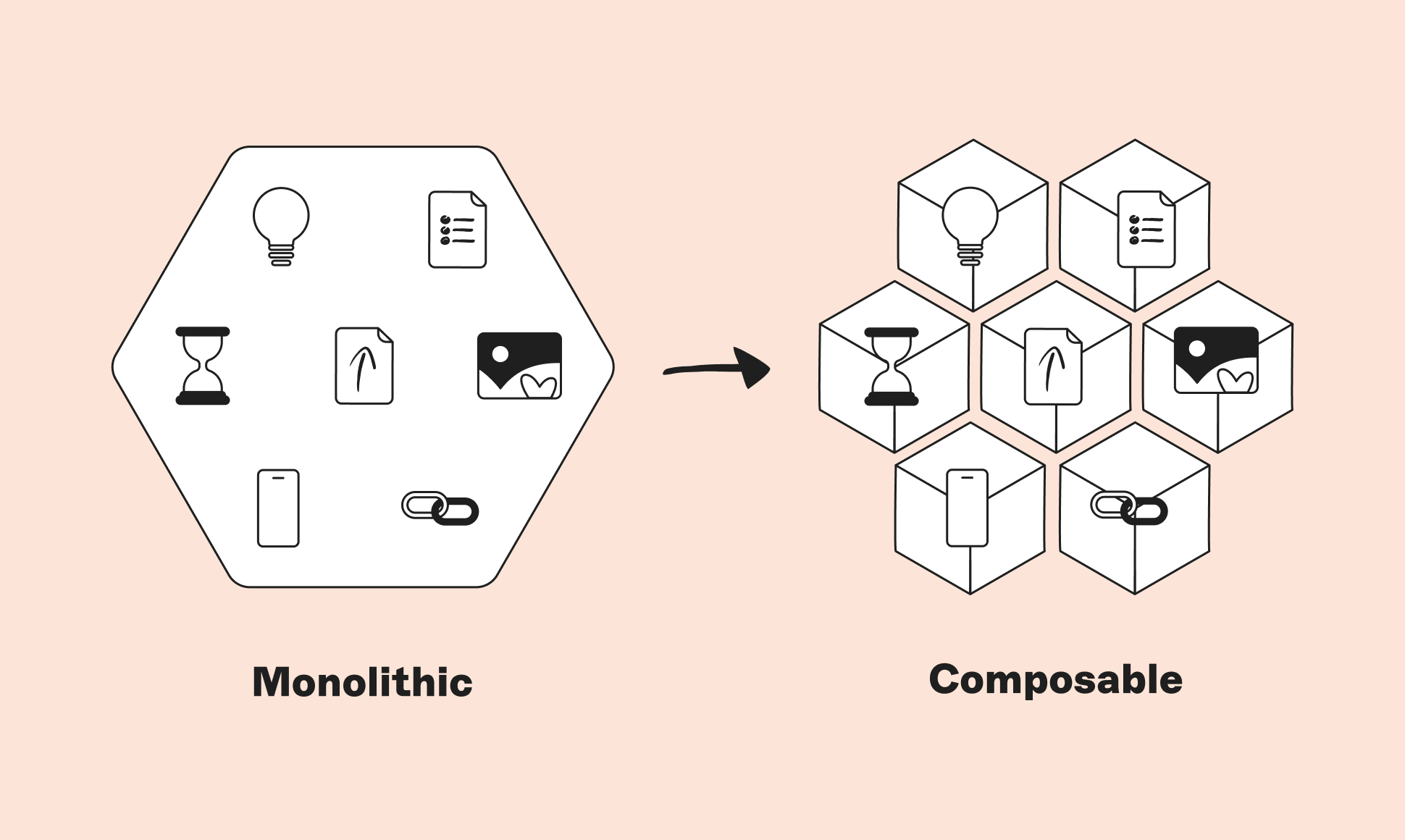Why Composable Is the New Norm
Storyblok is the first headless CMS that works for developers & marketers alike.

It wasn’t that long ago that a “new website” was a milestone every few years. Big launch, champagne, done. But the pace of digital has flipped. New platforms appear overnight, customers change their minds faster than your roadmap updates, and marketing teams can’t wait three months to test an idea. They need it live by next month.
Those old monolithic platforms? They did their job back when stability mattered more than speed. But today, they drag teams down. Adding one new feature can set off a chain of tickets, meetings, and reviews that kills momentum before the idea even gets tested.
This is why more organizations are shifting toward composable architecture — a modern foundation designed for speed and adaptability. Instead of one massive system you can’t move, composable works more like a neighborhood of smaller buildings. You can add a new one, remodel another, or swap something out without tearing down the whole block. That flexibility is what makes it fit for the way teams actually work today.
From monolithic to composable: how we got here
To understand why composable has become the new norm, it helps to look back at how digital platforms evolved.
- Monolithic systems: everything bundled into one platform. Reliable, but rigid. Adding new features often meant waiting months and incurring significant costs for custom development.
- Decoupled systems: a step forward — content and presentation layers were separated, giving teams a bit more flexibility, but still not true freedom.
- Headless CMS: APIs unlocked content so it could flow anywhere — websites, apps, wearables, smart devices. Marketers gained channel reach, but not always control.
- Composable architecture: the next leap. Instead of one giant system, composable breaks the stack into building blocks — content, commerce, analytics, personalization — that can be assembled, swapped, or extended as needed.

Why composable is becoming the norm
Composable is a practical response to the realities of modern business. Here’s why more organizations are making the shift:
1. Modularity through content modeling
A composable CMS doesn’t just separate front and back ends. It breaks content into reusable blocks — types, attributes, components — that editors can arrange and rearrange as needed. This is what turns flexibility from a buzzword into a daily reality.
2. Beyond headless: the full stack
Headless CMS gave businesses decoupling. Composable architecture goes further by unbundling the entire stack. Each capability — CMS, personalization, commerce, analytics — becomes a standalone module, or Packaged Business Capability (PBC), connected by APIs. Swap one tool, and the rest keep running smoothly.
3. Freedom from vendor lock-in
No more being stuck with “good enough” features inside an all-in-one suite. Composable lets you choose best-of-breed tools, plug them in, and upgrade them without downtime. You own the stack, not the other way around.
4. Speed and agility
Markets move fast. Composable makes it possible to test, launch, and iterate at the pace of customer expectations, whether that’s spinning up a campaign microsite or adding a new personalization engine.
5. Built-in resilience
Monolithic systems are fragile in strange ways. Touch one corner, and something breaks on the other side. Composable keeps those connections looser. If a service fails, it fails quietly — the rest carries on.
6. Empowered teams
It’s easy to focus on the technology behind composable. But the bigger story is what it does for the people using it. Developers are freed from endless integration work. Marketers can launch campaigns without waiting weeks for IT. Designers can try new ideas without worrying they’ll crash the system. That safety net means people actually take risks, and those risks are where the best ideas come from.
Industry momentum: from trend to standard
What once felt experimental is now becoming business as usual. The momentum is clear:
- Enterprises are leading the charge. Large retailers, finance firms, and media brands are rearchitecting their digital stacks around composability to scale and adapt across markets.
- Analysts are recognizing the shift. Forrester describes how a “truly composable DXP” must combine modular capabilities and uses composability as a signal of maturity in digital experience strategy.
- Vendors are adapting. Even traditional platform providers are breaking apart their suites, acknowledging that clients demand flexibility and choice over monolithic lock-ins.
In short, composable is rapidly becoming the standard approach to digital architecture, and organizations that delay risk being left behind.
Composable in practice: what it looks like
Theory is useful, but the real value of composable shows up in day-to-day business. Here’s how organizations are already putting it to work:
- Retail and e-commerce: launching a seasonal campaign no longer takes months of development. With composable, marketing teams can plug in a personalization engine, spin up localized microsites, and A/B test designs — all within weeks.
- Global brands: content created in one market can be reused across dozens of channels and countries. A composable CMS and DAM ensure consistency at scale while still allowing local teams to adapt messaging for their audience.
- Media companies: new platforms emerge constantly — TikTok today, something else tomorrow. Composable makes it easy to add channels to the distribution mix without ripping apart the existing stack.
- Financial services: regulatory changes can be implemented across digital properties quickly and cleanly, without disrupting customer experiences or risking compliance.
In each case, composability reduces friction. It gives teams the confidence that the tools they choose today won’t box them in tomorrow, and that their digital ecosystem can evolve as quickly as the business itself.
Composable + AI: the next frontier
If composable is the new standard, AI is what makes it indispensable for the future. But AI only performs as well as the content it’s given, and that’s where composability shines.
From blobs to building blocks
Many organizations still store content as long, undifferentiated “blobs” of text. AI struggles to understand or reuse that. A composable CMS breaks content into structured blocks — headlines, body text, CTAs, proof points — enriched with metadata so machines and humans know what each element means.
Why structure matters
Generative search, recommendation engines, and personalization all rely on structured content. When information is modular and tagged correctly, AI can remix it across formats, channels, and audiences. That means stronger SEO, more precise personalization, and content that’s truly future-proof.
Personalization at scale
Composable content models make it possible for AI to adapt the same piece of content to different contexts. One customer might see cost savings emphasized, while another sees scalability — all from the same structured building blocks.
How to prepare
Forward-looking teams are already laying the groundwork by:
- Auditing content libraries to identify unstructured “blobs”.
- Defining reusable blocks and metadata aligned with business needs.
- Establishing governance for naming conventions, taxonomies, and workflows.
- Testing across channels to ensure each block works on web, email, chat, and emerging interfaces.
Composable lays out the building blocks. AI comes along and rearranges them to fit the moment — scalability for one person, cost savings for another. Sounds a bit like magic, right? But really, it’s just structure teaming up with intelligence.
Future outlook: a shift in mindset
It’s important not to treat composability as just another tool in the stack. In reality, it changes the way teams approach digital work. Instead of saving everything for a major relaunch, they can ship smaller improvements, see what sticks, and keep refining.
Legacy platforms make the opposite true. A replatforming project drags on for months, integrations feel brittle, and even simple updates eat up budgets and patience. The companies that pull ahead will be the ones that treat composability as a way of working, not just a tech upgrade — modular, flexible, and ready to bend with whatever comes next.



